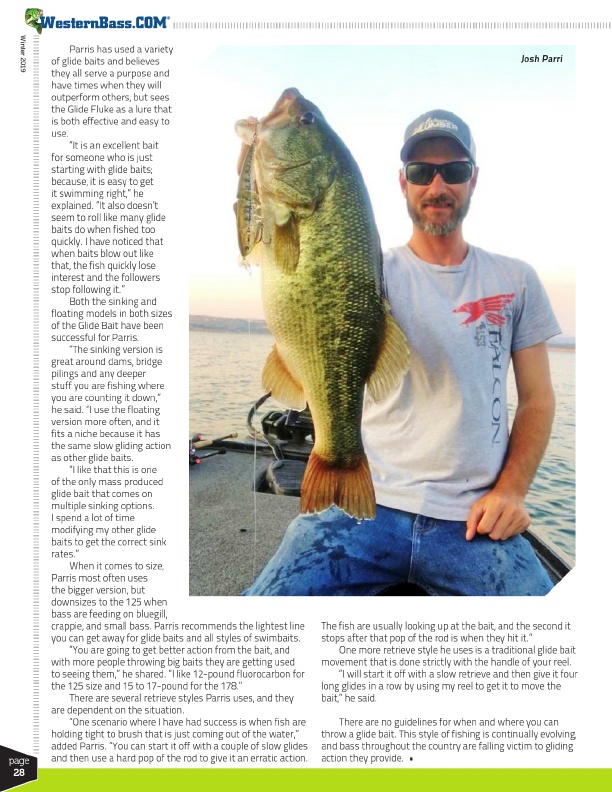
®
Winter 2019
page 28
Parris has used a variety of glide baits and believes they all serve a purpose and have times when they will outperform others, but sees the Glide Fluke as a lure that is both effective and easy to use.
“It is an excellent bait for someone who is just starting with glide baits; because, it is easy to get it swimming right,” he explained. “It also doesn’t seem to roll like many glide baits do when fished too quickly. I have noticed that when baits blow out like that, the fish quickly lose interest and the followers stop following it.”
Both the sinking and floating models in both sizes of the Glide Bait have been successful for Parris.
“The sinking version is great around dams, bridge pilings and any deeper stuff you are fishing where you are counting it down,” he said. “I use the floating version more often, and it fits a niche because it has the same slow gliding action as other glide baits.
“I like that this is one of the only mass produced glide bait that comes on multiple sinking options. I spend a lot of time modifying my other glide baits to get the correct sink rates.”
When it comes to size, Parris most often uses the bigger version, but downsizes to the 125 when bass are feeding on bluegill, crappie, and small bass. Parris recommends the lightest line you can get away for glide baits and all styles of swimbaits.
“You are going to get better action from the bait, and with more people throwing big baits they are getting used to seeing them,” he shared. “I like 12-pound fluorocarbon for the 125 size and 15 to 17-pound for the 178.”
There are several retrieve styles Parris uses, and they are dependent on the situation.
“One scenario where I have had success is when fish are holding tight to brush that is just coming out of the water,” added Parris. “You can start it off with a couple of slow glides and then use a hard pop of the rod to give it an erratic action.
Josh Parris
The fish are usually looking up at the bait, and the second it stops after that pop of the rod is when they hit it.”
One more retrieve style he uses is a traditional glide bait movement that is done strictly with the handle of your reel.
“I will start it off with a slow retrieve and then give it four long glides in a row by using my reel to get it to move the bait,” he said.
There are no guidelines for when and where you can throw a glide bait. This style of fishing is continually evolving, and bass throughout the country are falling victim to gliding action they provide. •